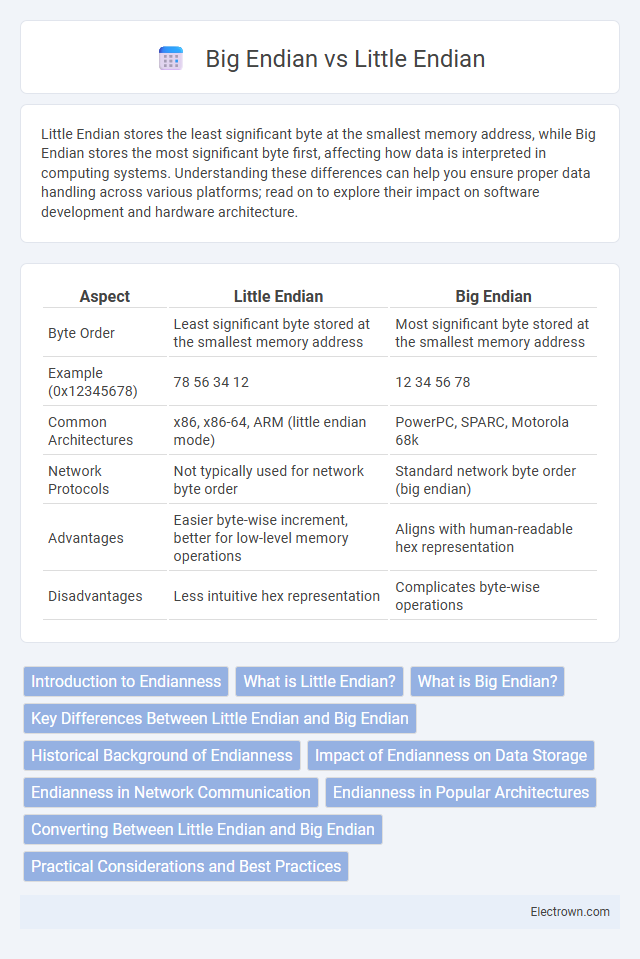Little Endian stores the least significant byte at the smallest memory address, while Big Endian stores the most significant byte first, affecting how data is interpreted in computing systems. Understanding these differences can help you ensure proper data handling across various platforms; read on to explore their impact on software development and hardware architecture.
Table of Comparison
| Aspect | Little Endian | Big Endian |
|---|---|---|
| Byte Order | Least significant byte stored at the smallest memory address | Most significant byte stored at the smallest memory address |
| Example (0x12345678) | 78 56 34 12 | 12 34 56 78 |
| Common Architectures | x86, x86-64, ARM (little endian mode) | PowerPC, SPARC, Motorola 68k |
| Network Protocols | Not typically used for network byte order | Standard network byte order (big endian) |
| Advantages | Easier byte-wise increment, better for low-level memory operations | Aligns with human-readable hex representation |
| Disadvantages | Less intuitive hex representation | Complicates byte-wise operations |
Introduction to Endianness
Endianness defines the order in which bytes are stored in computer memory, determining how multi-byte data types like integers are interpreted. In Little Endian format, the least significant byte is stored at the lowest memory address, while Big Endian places the most significant byte first. Understanding endianness is crucial for ensuring data compatibility across different systems and architectures, especially when you're working with low-level programming or network protocols.
What is Little Endian?
Little Endian is a byte order format where the least significant byte (LSB) is stored at the lowest memory address, making it easier for certain CPU architectures, like x86, to process data efficiently. This format is commonly used in Intel and AMD processors, optimizing performance for arithmetic operations by allowing immediate access to the least significant bytes. Little Endian contrasts with Big Endian, which stores the most significant byte at the lowest memory address, influencing data interpretation in network protocols and cross-platform software development.
What is Big Endian?
Big Endian is a data format where the most significant byte (MSB) is stored at the lowest memory address, making it the first byte read in sequences of multi-byte data. This byte order is commonly used in network protocols such as TCP/IP and in processors like PowerPC and SPARC. Understanding Big Endian is essential for software development involving cross-platform data exchange and network communication.
Key Differences Between Little Endian and Big Endian
Little Endian stores the least significant byte at the smallest memory address, while Big Endian places the most significant byte first, impacting how multi-byte data is interpreted. Endianness affects data exchange between different systems, requiring careful handling during network communication or file storage. Understanding these key differences ensures your software correctly processes byte order, preventing data corruption across varied architectures.
Historical Background of Endianness
Endianness originated from early computer architecture designs where memory storage patterns significantly impacted data interpretation across different systems. The terms "Little Endian" and "Big Endian" were popularized by Danny Cohen's 1980 paper, referencing Jonathan Swift's "Gulliver's Travels" to illustrate byte order conventions. Understanding the historical background reveals how proprietary hardware protocols and network communication standards influenced the adoption of these endian formats to ensure compatibility and data consistency.
Impact of Endianness on Data Storage
Endianness determines how bytes are ordered in memory, with Little Endian storing the least significant byte first and Big Endian storing the most significant byte first. This impacts data storage by affecting compatibility between systems, as mismatched endianness can lead to incorrect data interpretation. Your choice of endianness influences system design, data serialization, and network communication protocols to ensure consistent data exchange.
Endianness in Network Communication
Endianness in network communication is critical for ensuring consistent data interpretation across different systems, as network protocols typically use Big Endian format, also known as network byte order. Little Endian systems must convert data to Big Endian when sending, and back to Little Endian when receiving, to maintain interoperability and prevent data corruption. Understanding this byte order difference helps you design and troubleshoot network applications that communicate reliably across diverse architectures.
Endianness in Popular Architectures
Popular architectures differ in endianness: x86 and x86-64 CPUs use Little Endian format, storing the least significant byte at the lowest memory address, while older PowerPC and SPARC processors use Big Endian, placing the most significant byte first. ARM architectures support both modes, often configurable by the operating system, which affects data interpretation in cross-platform applications. Understanding endianness is crucial for developers working with binary data, ensuring Your software handles memory correctly across diverse hardware.
Converting Between Little Endian and Big Endian
Converting between Little Endian and Big Endian formats involves reversing the byte order of binary data to ensure correct interpretation across different systems. This process is critical in computing environments where data exchange occurs between architectures with differing endianness, such as x86 (Little Endian) and older mainframes (Big Endian). Efficient algorithms for byte swapping optimize performance in network communications, file storage, and cross-platform software development.
Practical Considerations and Best Practices
Little Endian format stores the least significant byte at the lowest memory address, making it the default for x86 and x86-64 architectures, which simplifies byte-wise operations and debugging on these platforms. Big Endian format places the most significant byte first, preferred in network protocols like TCP/IP for consistent data interpretation across heterogeneous systems. Best practices involve using endian-neutral libraries or explicitly converting byte order during data serialization and communication, ensuring interoperability and data integrity in distributed applications.
Little Endian vs Big Endian Infographic

 electrown.com
electrown.com